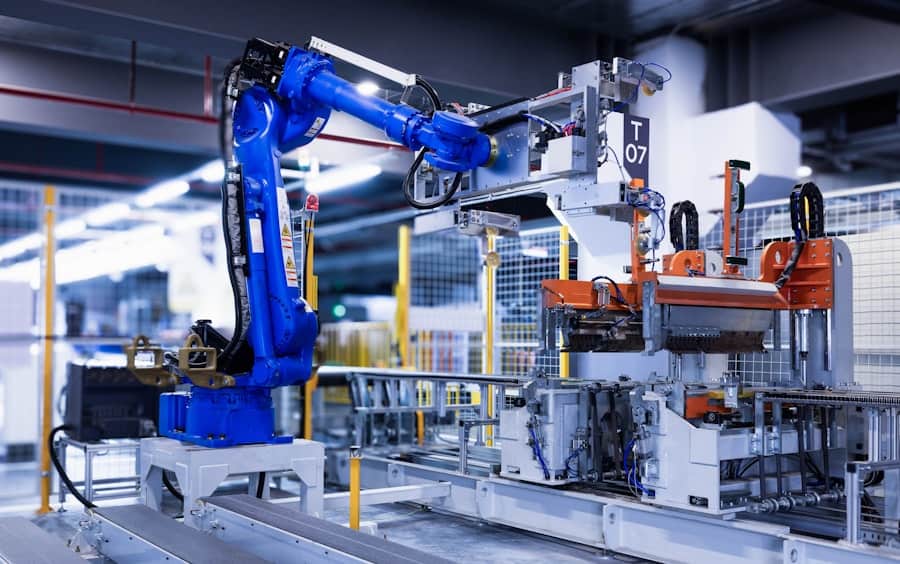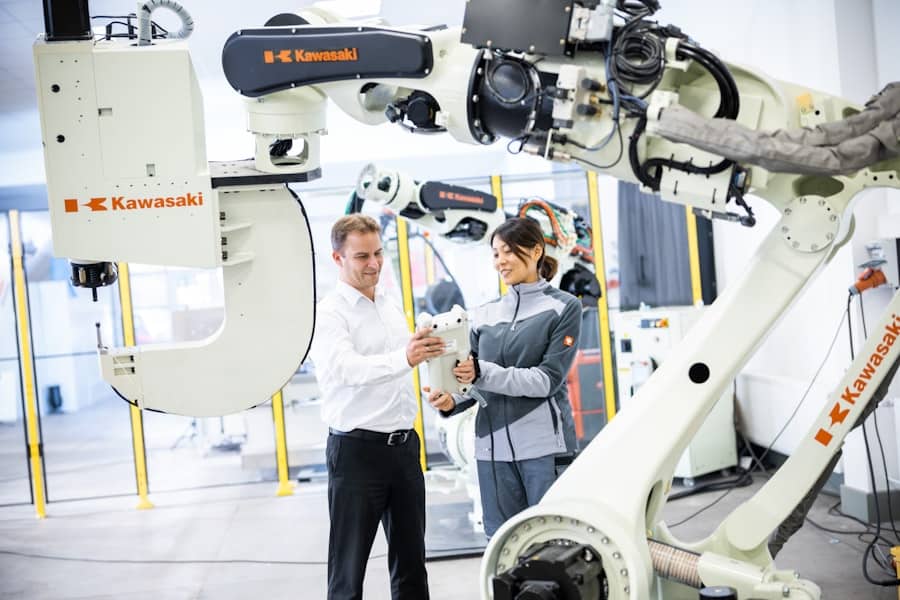The intersection of advanced robotics and large-scale 3D printing represents a transformative shift in manufacturing and construction processes. As industries increasingly seek innovative solutions to meet the demands of rapid production and customization, the integration of robotics into 3D printing systems has emerged as a pivotal development. This synergy not only enhances the capabilities of traditional 3D printing but also opens new avenues for creating complex structures and components that were previously deemed impractical or impossible.
The evolution of this technology is reshaping how we think about design, production, and even sustainability in various sectors. Large-scale 3D printing, often referred to as additive manufacturing, allows for the creation of substantial objects layer by layer, using materials ranging from plastics to metals and concrete. When combined with advanced robotics, this process gains a level of precision and efficiency that can significantly reduce production times and costs.
The ability to automate the printing process through robotic arms or mobile platforms enables manufacturers to produce intricate designs with minimal human intervention. This not only streamlines operations but also enhances safety by reducing the need for workers to be in potentially hazardous environments.
Key Takeaways
- Advanced robotics plays a crucial role in pushing the boundaries of 3D printing by enabling large-scale and complex structures to be printed with precision and efficiency.
- Advancements in robotic technology, such as multi-axis movement and adaptive control systems, have significantly improved the capabilities of large-scale 3D printing.
- Integrating robotics with 3D printing presents both challenges, such as programming and coordination, and opportunities, such as increased automation and customization.
- Advanced robotics has a significant impact on the efficiency and precision of large-scale 3D printing, leading to faster production times and higher quality output.
- The future of advanced robotics in large-scale 3D printing holds promising possibilities, including construction, aerospace, and medical applications, driven by artificial intelligence-enhanced robotics.
The Role of Advanced Robotics in Pushing the Boundaries of 3D Printing
Advanced robotics plays a crucial role in expanding the capabilities of large-scale 3D printing by enabling more complex geometries and larger structures. Traditional 3D printers are often limited by their size and the intricacy of the designs they can produce. However, with the integration of robotic systems, these limitations are significantly mitigated.
Robotic arms equipped with specialized nozzles can move freely in three-dimensional space, allowing for the creation of intricate designs that would be impossible with stationary printers. This flexibility not only enhances creativity in design but also allows for the production of customized components tailored to specific needs. Moreover, robotics facilitates the use of a wider range of materials in 3D printing processes.
For instance, robotic systems can handle viscous materials like concrete or even bio-based substances, which are increasingly being explored for sustainable construction practices. The ability to manipulate these materials with precision means that architects and engineers can experiment with new forms and structures that are both aesthetically pleasing and structurally sound. This capability is particularly valuable in industries such as construction, where the demand for innovative building techniques is on the rise.
Advancements in Robotic Technology for Large-Scale 3D Printing
Recent advancements in robotic technology have significantly enhanced the functionality and efficiency of large-scale 3D printing systems. One notable development is the emergence of collaborative robots, or cobots, which are designed to work alongside human operators. These robots are equipped with advanced sensors and AI algorithms that allow them to adapt to their environment and interact safely with humans.
In the context of 3D printing, cobots can assist in tasks such as material handling, setup, and quality control, thereby improving overall productivity while ensuring a safer working environment. Another significant advancement is the integration of machine learning algorithms into robotic systems. By leveraging vast amounts of data collected during the printing process, these algorithms can optimize various parameters such as speed, temperature, and material flow.
This real-time feedback loop enables robots to make adjustments on-the-fly, resulting in higher quality prints with fewer defects. Additionally, advancements in robotic vision systems allow for enhanced monitoring and inspection capabilities, ensuring that each layer is applied correctly and that any issues are detected early in the process.
Challenges and Opportunities in Integrating Robotics with 3D Printing
While the integration of robotics into large-scale 3D printing presents numerous opportunities, it also comes with its own set of challenges. One significant hurdle is the complexity of programming and controlling robotic systems for additive manufacturing applications. Unlike traditional manufacturing processes that follow a linear path, 3D printing requires robots to navigate intricate paths while maintaining precise control over material deposition.
Developing software that can effectively manage these complex movements while ensuring accuracy is a critical challenge that researchers and engineers continue to address. Another challenge lies in the compatibility of different materials with robotic systems. Not all materials used in 3D printing are suitable for robotic manipulation; some may require specific handling techniques or equipment modifications.
This necessitates ongoing research into material properties and how they interact with various robotic technologies. However, these challenges also present opportunities for innovation. As researchers work to overcome these obstacles, they are likely to develop new materials and techniques that could further enhance the capabilities of both robotics and 3D printing.
The Impact of Advanced Robotics on Efficiency and Precision in Large-Scale 3D Printing
The incorporation of advanced robotics into large-scale 3D printing has a profound impact on both efficiency and precision.
For instance, robotic systems can operate continuously without breaks, allowing for round-the-clock production capabilities.
This increased throughput is particularly beneficial in industries where time-to-market is critical, such as aerospace or automotive manufacturing. Precision is another area where robotics excels in large-scale 3D printing. The ability of robotic arms to execute complex movements with high accuracy ensures that each layer is deposited correctly, minimizing errors and reducing waste.
This level of precision is essential when producing components that must meet stringent tolerances or fit within larger assemblies. Furthermore, advanced robotics can facilitate multi-material printing, where different materials are combined within a single print job. This capability allows for the creation of hybrid structures that leverage the unique properties of each material, further enhancing performance and functionality.
Future Applications and Possibilities of Advanced Robotics in Large-Scale 3D Printing
The future applications of advanced robotics in large-scale 3D printing are vast and varied, spanning multiple industries from construction to aerospace. In construction, for example, robotic systems could be employed to print entire buildings on-site using sustainable materials like recycled plastics or bio-concrete. This approach not only reduces transportation costs but also minimizes waste by utilizing local resources effectively.
Additionally, the ability to create complex architectural forms could lead to more innovative designs that challenge traditional building methods. In aerospace manufacturing, advanced robotics could revolutionize how components are produced by enabling the creation of lightweight structures with intricate geometries that enhance performance while reducing material usage. The aerospace industry is already exploring additive manufacturing for producing parts like brackets and housings; however, integrating robotics could expand these applications further into critical load-bearing components.
Moreover, as regulations around air travel evolve to accommodate new technologies, the potential for on-demand production of aircraft parts using robotic 3D printing could streamline supply chains significantly.
The Role of Artificial Intelligence in Enhancing Robotics for Large-Scale 3D Printing
Artificial intelligence (AI) plays an increasingly vital role in enhancing the capabilities of robotics within large-scale 3D printing environments. By incorporating AI algorithms into robotic systems, manufacturers can achieve greater levels of automation and efficiency throughout the printing process. For instance, AI can analyze data from previous print jobs to identify patterns and optimize settings for future projects.
This predictive capability allows for continuous improvement in print quality while reducing material waste. Furthermore, AI-driven robotics can enhance decision-making processes during printing operations. For example, if a robot detects an anomaly or deviation from expected parameters—such as a change in material viscosity or temperature—it can autonomously adjust its actions to correct the issue in real-time.
This level of adaptability not only improves overall print quality but also reduces downtime associated with manual interventions or adjustments. As AI technology continues to advance, its integration into robotic systems will likely lead to even more sophisticated solutions for large-scale 3D printing challenges.
The Promising Future of Advanced Robotics in Large-Scale 3D Printing
The future of advanced robotics in large-scale 3D printing is filled with promise and potential for innovation across various sectors. As technology continues to evolve, we can expect to see even more sophisticated robotic systems capable of executing complex tasks with unparalleled precision and efficiency. The ongoing collaboration between robotics experts, material scientists, and engineers will undoubtedly yield new breakthroughs that push the boundaries of what is possible in additive manufacturing.
The integration of advanced robotics into large-scale 3D printing not only enhances current capabilities but also lays the groundwork for future innovations that could redefine entire industries. With continued investment in research and development, the potential applications are limitless, paving the way for a new era in manufacturing that leverages the strengths of both robotics and additive technologies.
In a related article discussing the future of technology, The Best Tablets for Business in 2023 explores the latest advancements in portable devices that are revolutionizing the way professionals work. As robotics and 3D printing continue to evolve, the integration of cutting-edge tablets into business operations will play a crucial role in enhancing productivity and efficiency. The intersection of these technologies is shaping the landscape of industries worldwide, paving the way for innovative solutions and unprecedented growth.
FAQs
What is large-scale 3D printing?
Large-scale 3D printing refers to the process of creating three-dimensional objects on a larger scale, typically using industrial-sized 3D printers. This technology allows for the creation of larger and more complex objects than traditional 3D printing methods.
What are the current applications of advanced robotics in large-scale 3D printing?
Advanced robotics is being used in large-scale 3D printing for applications such as construction, aerospace, automotive, and marine industries. This technology allows for the creation of large, complex, and customized structures and components.
How does advanced robotics improve large-scale 3D printing?
Advanced robotics improves large-scale 3D printing by increasing precision, speed, and efficiency in the printing process. Robots can handle the printing of large objects with greater accuracy and consistency, leading to higher quality end products.
What are the potential future developments in advanced robotics for large-scale 3D printing?
Future developments in advanced robotics for large-scale 3D printing may include the use of AI and machine learning to optimize printing processes, the development of more versatile and adaptable robotic arms, and the integration of advanced sensors for real-time monitoring and quality control.
What are the benefits of advanced robotics in large-scale 3D printing?
The benefits of advanced robotics in large-scale 3D printing include increased production speed, reduced labor costs, improved precision and quality, and the ability to create complex and customized structures that would be difficult or impossible to achieve with traditional manufacturing methods.



